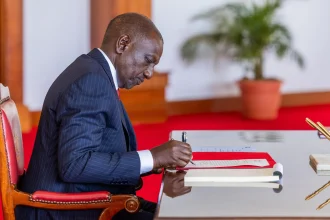When the Hustler Fund was launched in late 2022, it was hailed as a bold intervention aimed at democratising access to credit in Kenya.
Framed as a financial lifeline for the country’s “hustlers”—informal traders, micro-entrepreneurs, and unemployed youth—the fund promised to address decades-long exclusion from formal banking systems.
Fast forward two years, and its impact is the subject of fierce debate.
According to government data, over 20 million Kenyans have tapped into the Hustler Fund, with more than Sh60 billion disbursed. On the surface, these figures point to widespread uptake.
However, when scrutinised more deeply, they tell an incomplete story. While the number of beneficiaries is high, the average loan size—between Sh500 and Sh10,000—raises questions about the fund’s ability to catalyse meaningful economic transformation.
For micro-entrepreneurs operating in competitive informal markets, these amounts often fall short of what’s required to scale or sustain a business.
“Getting Sh 1,000 can’t start a business. It can maybe restock tomatoes, but that’s it,” explains Miriam, a kiosk owner in Gikambura. Her experience reflects a common refrain: the fund may serve immediate cash flow needs, but it is insufficient as a tool for enterprise development.
Accessibility is not everything
While the fund’s mobile-based accessibility is commendable, critics argue that its design lacks the structural pillars necessary for sustainable impact. Chief among these is financial literacy.
Many recipients report using the funds for household consumption rather than business investment, contributing to rising default rates.
“We need guidance, not just money,” says Samuel, a boda boda rider in Kisii. “No one taught us how to use it wisely.”
His comment points to a critical flaw: without training or mentorship, many first-time borrowers are caught in a cycle of borrowing and repayment without long-term benefit.
One economist underscores this, stating, “Financial inclusion is not just about access; it’s about sustainability. Without capacity-building, this becomes just another form of temporary relief.”
Indeed, this concern is backed by data. A 2024 Central Bank review found that over 35 per cent of borrowers had failed to repay their initial loans on time, raising alarms about the long-term viability of the program.
Beyond its technical design, the fund has also been dogged by concerns about transparency and equity. Reports have emerged alleging that politically connected individuals and entities have accessed disproportionately larger loans.
If substantiated, such claims undermine the fund’s egalitarian ethos and feed public skepticism about whether the Hustler Fund truly prioritises the average Kenyan hustler.
This concern touches on a broader historical pattern: public programs in Kenya have often been co-opted for patronage, with resources flowing toward those closest to political power. If the Hustler Fund is to break from this legacy, robust accountability mechanisms and public reporting must be instituted.
Success stories in the margins
Despite its flaws, the Hustler Fund has shown promise in isolated cases.
Jane, a salon owner in Machakos, used her initial Sh3,000 loan to buy new equipment. After successfully repaying, she qualified for a larger loan. “Now I make double what I used to,” she says.
Stories like Jane’s demonstrate that, when coupled with discipline and perhaps some prior business knowledge, even small capital injections can yield tangible results.
However, these success stories are often the exception rather than the norm, and their existence does not negate the systemic issues that the majority face.
As Kenya continues to grapple with high unemployment, currency depreciation, and inflationary pressures, the need for inclusive economic policy is greater than ever. The Hustler Fund remains a high-stakes experiment – part innovation, part political statement.
For it to fulfil its original promise, several reforms are necessary. Linking repayment performance to higher credit limits is a step in the right direction, but the fund must raise the ceiling on initial loans to reflect real business needs.
The Fund must come up with capacity building programmes where mandatory financial literacy programs – delivered via mobile or in-person workshops – should accompany loan disbursement.
Providing independent audits and public dashboards, as monitoring and evaluation tools, could enhance transparency and rebuild trust.
There is a need for differentiated support as not all hustlers are the same. The fund could tailor packages for traders, farmers, service providers, and others based on their distinct needs and risk profiles.
Ultimately, the Hustler Fund is not just a question of economics – it is a test of political will.
Can Kenya’s leadership move beyond symbolism to build systems that genuinely empower the marginalised? The answer will define not just the fate of the fund, but also the economic prospects of millions who have long been excluded from the formal financial system.












